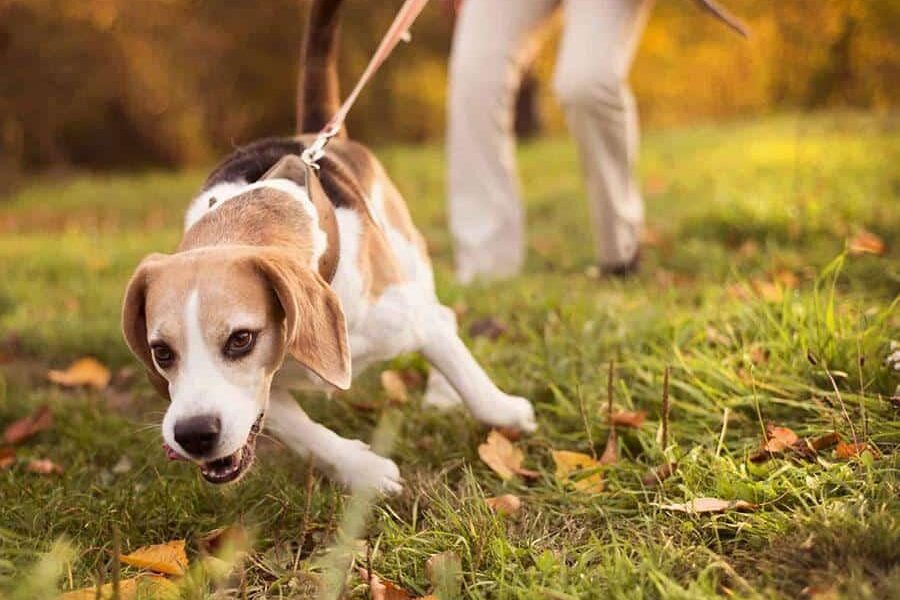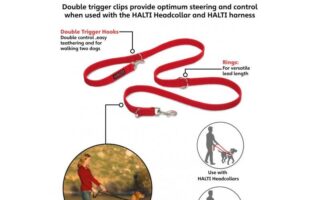Title: Tackling the Tug – Understanding Your Dog’s Pulling Habit on Walks
Walking your dog should be a delightful experience — a chance to bond, explore new smells, and bask in the fresh air together. Yet, for many dog owners, this joyful outing often turns into a tug-of-war contest. If your furry friend drags you down the street, pulling with all their might as if racing after an unseen rabbit, you’re not alone. This common challenge can transform a simple stroll into a battle of wills, leaving you frustrated and your canine companion overstimulated. In this article, we’ll delve into the reasons behind this pulling behavior, explore its impact on both you and your dog, and offer practical solutions to turn those chaotic walks into a harmonious adventure. Whether you’re a seasoned pet parent or a newcomer to the world of dog ownership, understanding the root causes of leash pulling is the first step toward a more enjoyable experience for both you and your spirited companion.
Table of Contents
- Understanding the Root Causes of Your Dogs Pulling Behavior
- Effective Training Techniques to Encourage Loose Leash Walking
- Choosing the Right Equipment for a More Controlled Walk
- Establishing a Consistent Routine for Better Walks and Bonding
- Q&A
- Concluding Remarks
Understanding the Root Causes of Your Dogs Pulling Behavior
When your dog pulls vigorously on the leash, it can feel like an unending battle of wills. However, understanding what motivates this behavior can help you address it effectively. Dogs are naturally curious creatures, often driven by their instincts and the desire to explore their surroundings. They might be eager to chase after other animals, investigate intriguing scents, or simply socialize with other people and dogs. Additionally, a dog’s energy levels and lack of sufficient exercise can contribute to this pulling behavior, making them more prone to racing ahead in excitement.
Identifying the root causes of your dog’s pulling is essential for developing a tailored training approach. Some common reasons may include:
- Leash Training Experience: Whether your dog has received proper leash training can significantly impact their pulling behavior.
- Breed Characteristics: Certain breeds, particularly those bred for herding or hunting, may have a stronger instinct to pull or lead.
- Excitement Levels: High energy and excitement can easily translate into pulling if not managed.
- Distraction Factors: Other dogs, people, or interesting smells can take your dog’s focus away from you, resulting in pulling.
By analyzing these factors, you can begin to design a training plan that addresses your dog’s specific motivations. Consider keeping a log of their behavior during walks, noting any triggers that may lead them to pull. This insight will assist you in implementing effective strategies to transform your walking experience.
Effective Training Techniques to Encourage Loose Leash Walking
Transforming your dog’s pulling habit into a comfortable walking experience requires consistency and patience. One effective technique is to practice the Stop and Go method. Whenever your dog pulls, simply halt your progress and stand still. Wait for a moment until your dog returns to your side or pays attention to you. Once they do, immediately praise them and resume your walk. This method teaches your dog that pulling doesn’t lead to adventure but staying close does. Incorporating short training sessions multiple times a day can reinforce this behavior, creating positive associations with loose leash walking.
Another powerful strategy is rewarding good behavior with treats or praise. Consider using a clicker during your walks; every time your dog walks beside you without pulling, use the clicker followed by a treat. This helps to build positive reinforcement into your training regimen. Additionally, try using a front-clip harness, which can gently redirect your dog’s attention back to you if they start to pull. Here’s a quick guide to effective rewards:
| Reward Type | Description |
|---|---|
| Verbal Praise | Encourage your dog with enthusiastic praise when walking nicely. |
| Treats | Offer small, high-value snacks for maintaining a loose leash. |
| Toys | Bring a favorite toy and play with them when they walk without pulling. |
Choosing the Right Equipment for a More Controlled Walk
Finding the right gear is essential for transforming your daily walks into a more controlled and enjoyable experience. Consider the following options when selecting equipment:
- Front-Clip Harness: This design significantly reduces pulling by redirecting your dog’s attention back towards you.
- Head Halter: A great tool for controlling enthusiastic pullers without harsh restraints, allowing for gentle guidance.
- Training Leash: Opt for a padded, adjustable leash that provides comfort while maintaining control.
- Martingale Collar: With its limited-slip design, this collar prevents escape without causing discomfort.
Don’t underestimate the importance of fit; poorly fitting equipment can lead to discomfort or even injury. Ensure that any harness or collar is tailored to your dog’s size and breed. Here’s a simple guide to help you measure:
| Measurement | How to Measure |
|---|---|
| Neck Circumference | Wrap a cloth tape around the base of your dog’s neck. |
| Chest Girth | Measure around the widest part of your dog’s chest. |
| Body Length | From the shoulder to the base of the tail. |
Establishing a Consistent Routine for Better Walks and Bonding
Creating a routine not only aids in reducing unwanted pulling on walks but also strengthens the bond between you and your dog. Begin by designating specific times for daily walks. Dogs thrive on consistency, and having a set schedule prepares them mentally for the outing. Start with brief sessions that gradually increase in duration, allowing your dog to adapt while practicing good behaviors. During these walks, incorporate fun activities to keep your dog engaged, such as:
- Frequent stops: Allow opportunities for sniffing and exploring.
- Short training sessions: Introduce basic commands like ”sit” or “heel” at intervals.
- Positive reinforcement: Use treats or praise for good walking manners.
As you establish this routine, remember that patience is key. Cloud your walks with the joy of discovery rather than the stress of pulling. To make the experience even more enjoyable, consider using a simple chart to track progress, noting improvements each week. Below is a sample table you can use to track your dog’s behaviors over time:
| Week | Pulling (Yes/No) | Progress Notes |
|---|---|---|
| 1 | Yes | Shorter walks, eager but distracted. |
| 2 | No | Increased focus, responding well to commands. |
| 3 | No | More exploratory behavior, less pulling. |
Utilizing a consistent routine helps in achieving better walks and enhances the overall relationship with your furry companion. Celebrate each small victory, and gradually, you’ll notice the leash becoming a more relaxed tether between you and your dog.
Q&A
Q&A: My Dog Pulls So Hard on Walks!
Q: Why does my dog pull so hard on walks?
A: Dogs naturally have a strong sense of curiosity and energy. Pulling can stem from excitement about their environment, an eagerness to reach other dogs or people, or simply pent-up energy that needs to be released. It’s their way of exploring the world!
Q: Is this behavior normal for dogs?
A: Absolutely! Many dogs pull on the leash during walks, especially if they haven’t been trained otherwise. It’s a common issue and can be addressed with some patience and the right techniques.
Q: What can I do to stop my dog from pulling?
A: Start by teaching your dog loose-leash walking. When they begin to pull, stop walking and wait for them to return to your side. Reward them for walking calmly. You can also try using a front-clip harness, which encourages them to face you instead of pulling ahead.
Q: Are there specific training methods that can help?
A: Yes! Employ techniques like the “stop-and-go” method, where you pause whenever your dog pulls, or the “turn-around” technique, where you change direction suddenly when they tug. Positive reinforcement, like treating or praising your dog for walking beside you, can make a significant difference too.
Q: How long will it take for my dog to stop pulling?
A: Results can vary based on your dog’s behavior and the consistency of your training. Some dogs may show improvements within days, while others may take weeks. Consistency, patience, and regular practice are key.
Q: Should I use a training collar or other equipment?
A: While certain collars and tools can aid in training, they should not be punitive. Opt for no-pull harnesses or head halters designed to discourage pulling without causing harm. Always prioritize comfort and safety for your dog.
Q: When should I consult a professional trainer?
A: If you’ve tried various techniques without success or if your dog’s pulling is excessive and leads to potential injuries, consider reaching out to a professional trainer or behaviorist. They can provide tailored guidance suited to your dog’s unique needs.
Q: Can pulling on walks affect my dog’s health?
A: Yes, pulling can lead to physical issues over time, such as strain on the neck and spine, especially if a traditional collar is used. Encouraging loose-leash walking minimizes these risks and promotes a more enjoyable experience for both you and your dog.
Q: How can I make walks more enjoyable for my dog?
A: Incorporating games, allowing plenty of sniffing time, and varying your walking routes can keep walks exciting for your dog. The goal is to create a fun and engaging experience that reduces the urge to pull and enhances your bond.
By addressing the issue of pulling on walks with understanding and effective techniques, both you and your dog can enjoy the simple pleasure of a stroll together. Happy walking!
Concluding Remarks
navigating the challenges of a dog that pulls hard on walks can often feel like a daunting task, but it also presents a valuable opportunity for growth—both for you and your furry companion. By employing the right techniques and maintaining a consistent approach, you can transform those chaotic outings into enjoyable adventures filled with exploration and connection. Remember, patience and persistence are key; every step taken together is a step toward a stronger bond. So, as you lace up your shoes and clip on that leash, embrace the journey ahead—one pull at a time. Happy walking!



